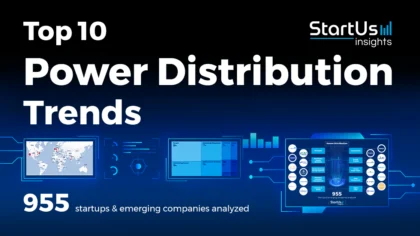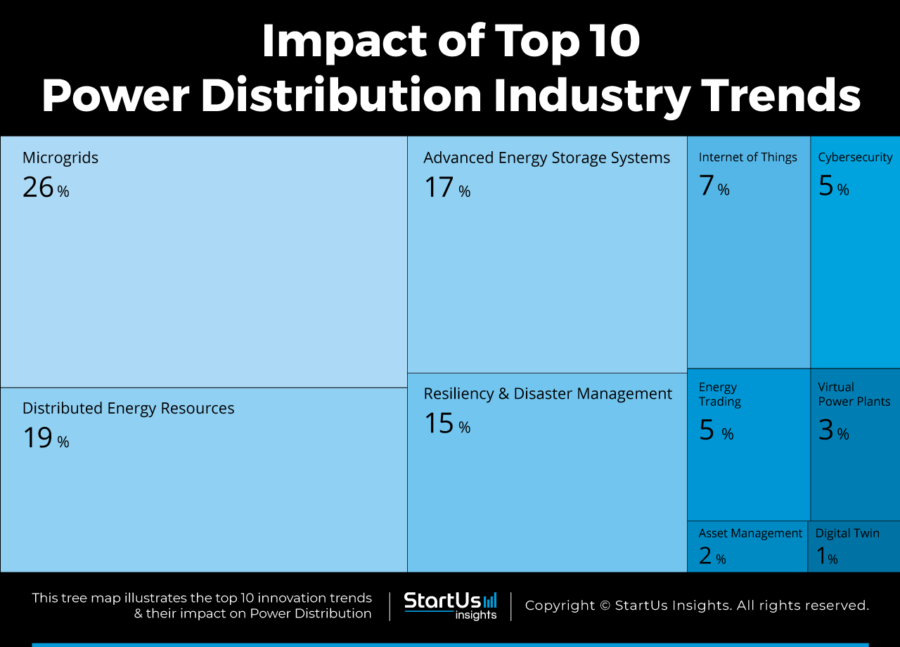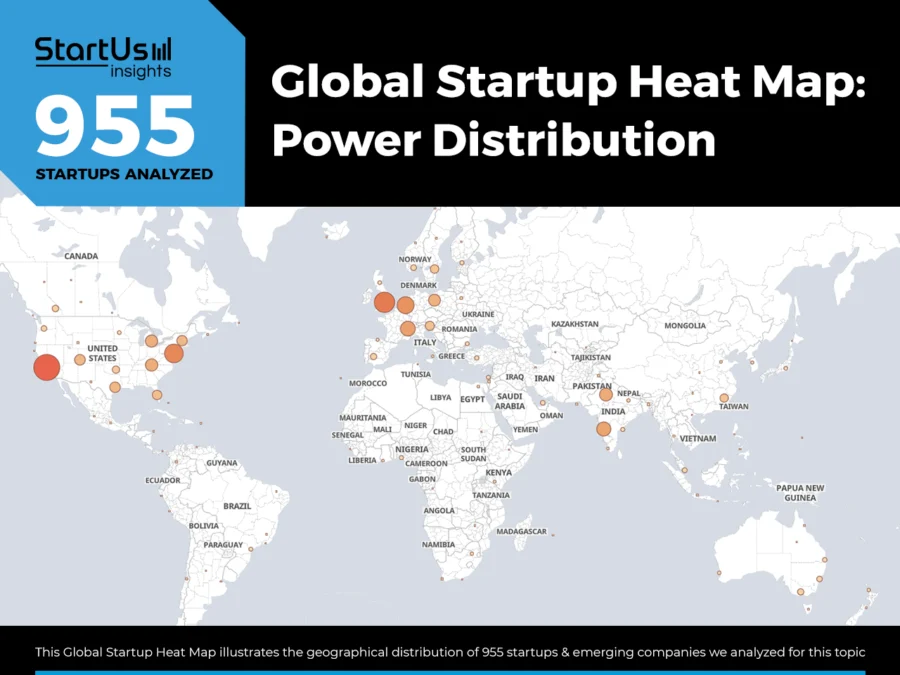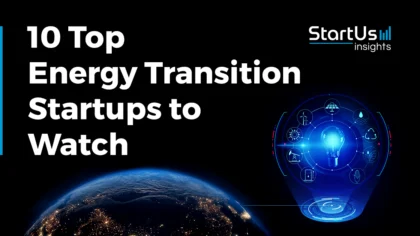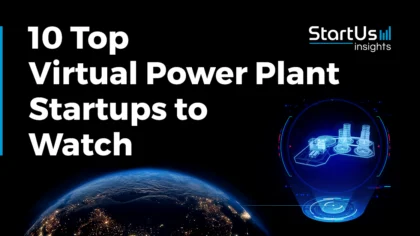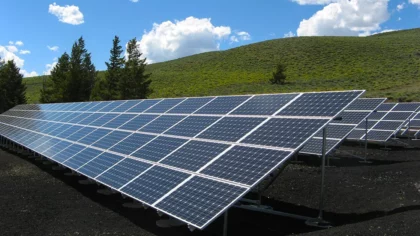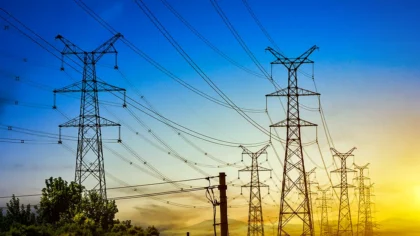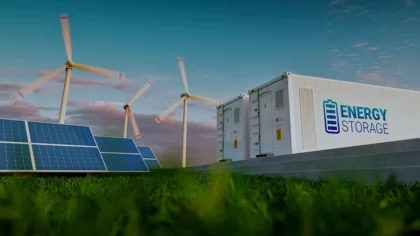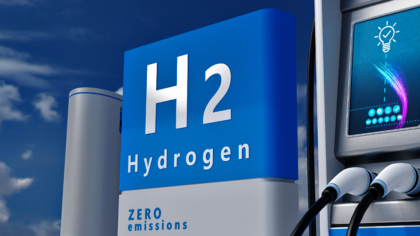Accelerate Productivity in 2025
Reignite Growth Despite the Global Slowdown
The power distribution sector addresses the challenges of enhancing energy accessibility, improving system reliability, and reducing environmental impacts amid rising energy demands. Innovative technologies like microgrids, photovoltaics (PV), wind energy, and advanced energy storage systems (ESS) increase the efficiency, security, and resilience of power distribution infrastructures. These advances significantly impact the energy sector and also industries such as manufacturing, retail, healthcare, and transportation, which rely heavily on a continuous power supply.
Top 10 Future Trends in Power Generation (2025)
- Microgrids
- Distributed Energy Resources
- Advanced Energy Storage Systems
- Resiliency & Disaster Management
- IoT in Power Distribution
- Cybersecurity
- Energy Trading
- Virtual Power Plants
- Asset Management for Power Distribution
- Digital Twin
Methodology: How We Created the Power Distribution Trend Report
For our trend reports, we leverage our proprietary StartUs Insights Discovery Platform, covering 5M+ global startups, 20K technologies & trends plus 150M+ patents, news articles, and market reports.
Creating a report involves approximately 40 hours of analysis. We evaluate our own startup data and complement these insights with external research, including industry reports, news articles, and market analyses. This process enables us to identify the most impactful and innovative trends in the power distribution industry.
For each trend, we select two exemplary startups that meet the following criteria:
- Relevance: Their product, technology, or solution aligns with the trend.
- Founding Year: Established between 2020 and 2025.
- Company Size: A maximum of 200 employees.
- Location: Specific geographic considerations.
This approach ensures our reports provide reliable, actionable insights into the power distribution innovation ecosystem while highlighting startups driving technological advancements in the industry.
Innovation Map outlines the Top 10 Power Distribution Trends & 20 Promising Startups
For this in-depth research on the Top Power Distribution Trends & Startups, we analyzed a sample of 900+ global startups & scaleups. The Power Distribution Innovation Map created from this data-driven research helps you improve strategic decision-making by giving you a comprehensive overview of the power distribution industry trends & startups that impact your company.
Tree Map reveals the Impact of the Top 10 Power Distribution Technology Trends in 2025
Based on the Electricity Distribution Innovation Map, the Tree Map below illustrates the impact of the Top 10 Future Trends in Power Distribution. Innovations in microgrids and distributed energy resources (DERs) decentralize power generation for localized solutions. Advanced energy storage systems (ESS) ensure consistent supply and balance demand. IoT provides real-time monitoring, while cybersecurity protects infrastructures. Energy trading and virtual power plants (VPPs) enable efficient exchanges. Further, digital twins simulate and optimize system performance for a resilient energy future.
Global Startup Heat Map covers 955 Power Distribution Startups & Scaleups
The Global Startup Heat Map showcases the distribution of 900+ exemplary startups and scaleups analyzed using the StartUs Insights Discovery Platform. It highlights high startup activity in the US and Western Europe, followed by India. From these, 20 promising startups are featured below, selected based on factors like founding year, location, and funding.
Want to Explore Power Distribution Innovations & Trends?
Top 10 Trends in Power Generation (2025)
1. Microgrids
Power distribution networks in many regions of the world face a multitude of issues including inefficiency, lack of resilience, and central control. Microgrids are small-scale localized power system alternatives that address these challenges by combining decentralized energy generation, distribution, and storage.
The global microgrid market is estimated at USD 37.6 billion in 2024 and is projected to reach USD 87.8 billion by 2029, with a CAGR of 18.5% from 2024 to 2029.
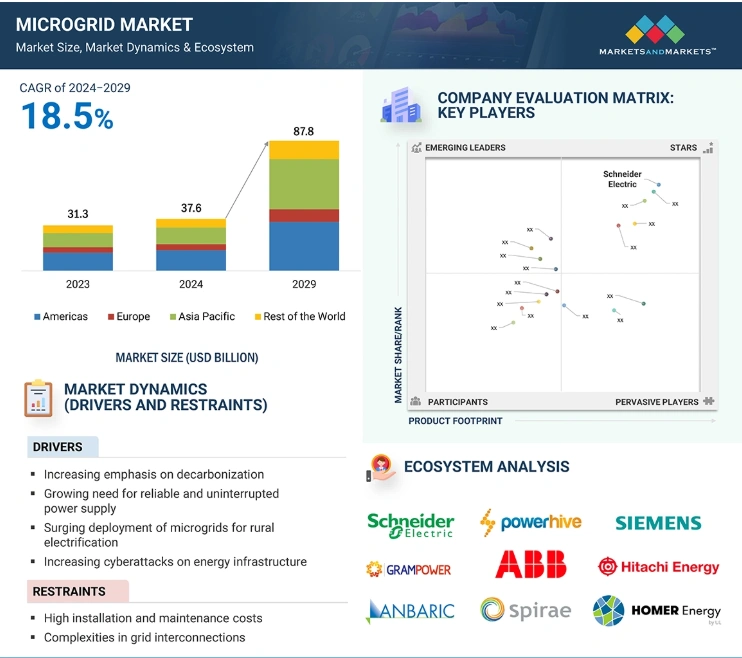
Credit: Markets and Markets
Additionally, microgrids optimize energy consumption through the implementation of smart grid technologies such as real-time monitoring and demand response. This also ensures better load balancing and provides more reliable power to remote or underserved areas.
SolMicroGrid provides Energy as a Service
US-based startup SolMicroGrid operates solar-enabled microgrid systems for commercial and industrial clients. Its systems integrate solar panels, battery storage, and generators, managed by intelligent controls, to provide efficient and resilient power solutions.
This setup lets businesses generate and store renewable energy on-site to ensure continuous operations during power outages and reduce reliance on the traditional grid. The startup offers Energy as a Service, and eliminates upfront capital investment, allowing clients to pay only for the power they use at lower rates. The startup’s solutions enhance energy efficiency, lower operating costs, and decrease carbon emissions.
CE+T Energrid simplifies Microgrid Power Management
CE+T Energrid is a Belgian startup that provides an advanced energy management system to optimize the use of renewable energy systems. The startup’s power management system (PMS) streamlines energy flows using storage solutions and smart controls. The PMS also charges or discharges the battery storage system to maximize self-consumption and peak shavings without any direct intervention.
CE+T Energrid’s PMS integrates with external energy management systems (EMS) to optimize consumption and production. This way, energy companies leverage real-time weather forecasting and data from energy markets. The startup’s solutions find applications in remote areas to provide self-sustainable power by connecting loads, renewable energy sources, and batteries to the grid.
2. Distributed Energy Resources
Limited access to electricity due to inadequate grid infrastructure is one of the main challenges in remote areas, especially in developing countries. That is why startups are deploying DERs, leveraging solar panels, wind turbines, energy storage systems, and microturbines.
The distributed energy resource management systems (DERMS) market is projected to grow from USD 0.61 billion in 2024 to USD 1.44 billion by 2029, with a CAGR of 18.8%.
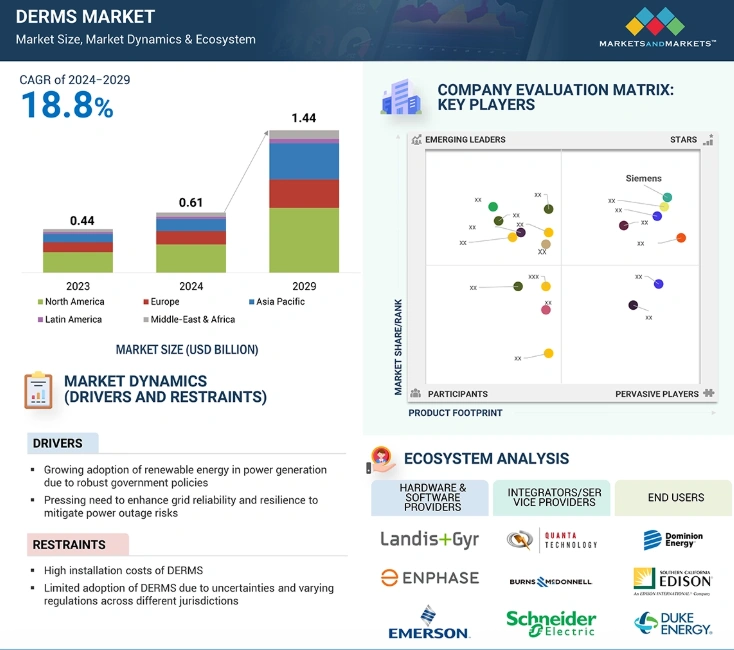
Credit: Markets and Markets
By leveraging DERs, power distribution becomes more resilient and reliable, reducing the impact of outages caused by storms or other disruptions. Further, DERs enable mini-grids and microgrids, bringing electricity to off-grid and underserved areas.
These solutions contribute to more decentralized and sustainable power distribution systems. This improves energy access, grid reliability, and clean energy adoption.
Xendee aids DER Portfolio Analysis
Xendee is a US-based startup that offers a platform for optimizing DERs and microgrid sites. The startup’s DISCOVER tool integrates with internal and external data sources, including data on technology, tariff, energy load, and weather, to identify optimal sites. Besides, the tool offers insights into site-specific capital and operating expenditure, potential revenue generation, and carbon savings.
The startup also offers OPERATE, a plug-and-play EV charging and microgrid controller. It automates system management using AI and machine learning. Xendee’s platform enables grid and utility operators to analyze and prioritize customer site portfolios for potential DER and microgrid locations.
Lunar Energy facilitates Home Electrification
Lunar Energy is a US-based startup that offers a comprehensive energy management platform – Lunar Gridshare. It optimizes a large number of DERs in dynamic markets by connecting with third-party devices such as smart meters, IoT devices, and energy storage systems.
Through this, the platform gathers real-time data to predict energy usage patterns at both household and fleet levels. This predictive capability allows for better energy allocation, reducing costs, and improving overall energy management.
Lunar Energy also offers Lunar System, a solution that combines a battery, bridge, maximizers, and a companion app. It uses solar panels to capture, store, and control energy. The startup’s energy management solution solves the problem of intermittent power supply and minimizes outages.
3. Advanced Energy Storage Systems
The production of energy is not constant at all given times and therefore compounds issues such as inadequate load balancing and peak demand management.
Advanced energy storage systems feature large-scale batteries, flywheels, and compressed air energy storage. They enable the storage of excess electricity during periods of low demand and its release during peak demand periods.
By integrating ESS into power distribution networks, operators enhance grid stability, improve voltage regulation, and optimize the utilization of renewable energy sources. Additionally, advanced ESSs facilitate the integration of intermittent renewables, like solar and wind, by compensating for fluctuations.
Further, the advanced energy storage systems market is projected to grow from USD 86.43 billion in 2024 to USD 159.12 billion by 2032, with a CAGR of 7.93% during this period.
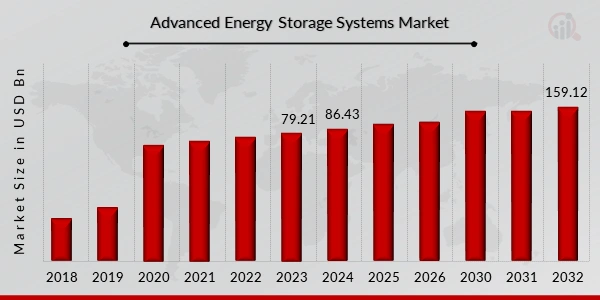
Credit: Market Research Future
Advanced Microgrid Solutions develops Vanadium Redox Flow Batteries
Advanced Microgrid Solutions is a Singaporean startup that provides affordable microgrid power generation solutions. The startup’s VFlowTech vanadium redox flow battery has a higher energy density than conventional solutions. It also reduces parasitic losses, features low setup costs, and minimal maintenance requirements.
The startup also utilizes additives to support wider operating temperatures. Besides, it offers a range of products, including the PowerCube series, for applications such as residential storage, telecom towers, solar trackers, and off-grid solutions.
Visionary manufactures a Portable Power Station
US-based startup Visionary specializes in energy storage for power distribution grids. Its decentralized energy storage solution delivers reserve energy for longer periods when the primary power source is unavailable. The startup also offers the Power Kubik, a portable power station with green energy backup. Power Kubik comes in two types of boxes – for energy backup and voltage stabilizing – providing safety for electric devices at home and charging gadgets on the go.
Visionary’s Power Module is a scalable power backup with a capacity of 6500W as well as features for advanced analytics and remote data management. Moreover, Visionary’s cloud service aggregates distributed Power Module units into virtual energy storage, supporting the local grid and improving the efficiency and reliability of the power grid.
4. Resiliency & Disaster Management
The global disaster preparedness systems market is growing to USD 206.35 billion in 2025 and is projected to reach USD 426.45 billion by 2034, with a CAGR of 8.4% between 2024 and 2034.
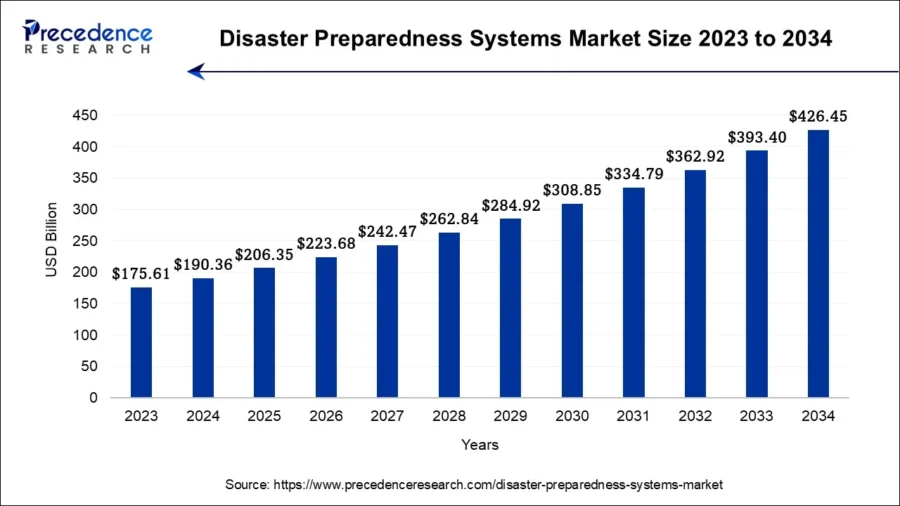
Credit: Precedence Research
Natural disasters, such as hurricanes, earthquakes, and wildfires, pose a major threat to power infrastructure, leading to prolonged outages and disruptions.
Additionally, aging grid infrastructure and inadequate preparedness for extreme weather events exacerbate the problem. Advanced technologies, including predictive analytics and real-time monitoring systems, enable early detection and rapid response to such issues.
The integration of microgrids and decentralized energy systems further enhances resiliency by providing localized power generation and storage. This ensures continuity during grid failures.
Moreover, grid hardening measures, such as underground cabling and reinforced infrastructure, improve the infrastructure’s ability to withstand natural disasters, preventing outages and enhancing the resilience of the electric grid.
RPower provides Grid Resilience-as-a-Service (RaaS)
US-based startup RPower specializes in a range of power generation and energy management solutions including microgrids and resilience-as-a-service. The startup’s resilience-as-a-service solution ensures reliable, uninterrupted power and it also offers the design, installation, operation, and maintenance of microgrid systems.
RPower’s microgrid solutions improve resiliency and offer cost savings, focusing on both island mode operation and grid-synchronized systems. The startup also provides a design-build-transfer option for customers who prefer to own the microgrid equipment. RPower’s services enhance the operational resilience of power distribution infrastructure and services.
CellCube improves Critical Asset Protection from Power Outages
CellCube is an Austrian startup that specializes in long-duration energy storage systems using sustainable energy. The startup utilizes vanadium redox flow battery technology to store and shift renewable energy. CellCube’s system supports various applications, including integration with renewable energy, microgrids, and off-grid storage.
Moreover, the startup provides long-duration backup energy storage systems for outage protection. This offers security for critical infrastructure like hospitals, utilities, etc., ensuring a reliable energy supply. Furthermore, it is capable of supporting businesses with more than 12 hours of backup electricity each day.
It also features a maximum power draw at 200% of its nominal power to ensure minimal interruption. CellCube’s solutions strengthen the resilience of operations, offering a reliable backup solution with a fast response time in the event of power outages.
5. IoT in Power Distribution
Consumers are consistently facing rising energy costs due to the lack of real-time monitoring, inefficient energy consumption, and limited grid intelligence.
Therefore, energy utility companies are integrating smart meters, sensors, and automation systems into power distribution networks. This way, they gain real-time visibility and control over energy flow.
Moreover, IoT enables proactive maintenance to identify potential issues early on and optimize asset management. IoT-enabled smart grids also facilitate demand response programs, allowing consumers to adjust their energy usage based on real-time price signals. This results in reduced peak demand and improved grid efficiency.
Inclusive Energy enables Remote Energy Asset Monitoring
Inclusive Energy is a UK-based startup that creates software and hardware for the monitoring and maintenance of biogas digesters. The startup’s Smart Biogas is a real-time monitoring system that utilizes IoT sensors to monitor digester health and sends data to the cloud.
Additionally, its small off-grid energy kit, Micro-Power, uses a smart charge controller, Cloud Solar, to enable remote monitoring and control. Besides, the startup’s Street Smart range of solar street lights assists utility operators with real-time solar asset management, controllable electricity output, and remote management.
nLine facilitates Critical Energy Infrastructure Monitoring
US-based startup nLine provides sensors and analytics to measure and improve energy systems like microgrids and national grids. The startup’s GridWatch technology offers remote monitoring of power quality and reliability using a novel sensor that plugs into outlets. The platform also delivers automatic notifications when sensors go down and also aggregates grid-wide metrics in a live dashboard. This data allows operators to improve the performance of critical infrastructure and support sustainable energy use through real-time reporting.

6. Cybersecurity
Utilities are digitizing power grids to achieve transparency and efficiency but, at the same time, increasing the exposure to malicious attacks. They disrupt essential services through cyber attacks, data breaches, and unauthorized access. Therefore, energy distributors are leveraging innovations in cybersecurity to mitigate these risks.
Advanced encryption, network segmentation, and robust authentication mechanisms secure communication and data exchange within power distribution systems.
Additionally, continuous monitoring, threat detection, and incident response systems identify and respond to potential cyber threats promptly. These solutions safeguard the power distribution systems to ensure uninterrupted delivery of electricity.
Splight offers AI-based Security for Power Distribution Assets
Splight is a US-based startup that develops a proprietary AI platform for grid security. It features a neural network framework with interconnected layers. The platform collects grid asset data through networks and proprietary connectors to address problems in electricity generation, storage, and transmission.
Besides, Splight’s remote monitoring platform functions with just a basic internet connection and any industry protocol as well as includes cybersecurity layers. Through this solution, power grid operators secure their digital assets and facilitate the monitoring of energy infrastructure and energy generation.
Utiltyx aids Grid-Edge Device Monitoring
Utiltyx is a US-based startup that safeguards complex power grids and their interconnectivity from external cyber threats using its GRID EYE platform. Its DER-aware cybersecurity solution for smart grids utilizes AI-powered monitoring to analyze anomalies, detect malware, and prevent intrusions.
Additionally, the platform offers comprehensive visibility of all connected devices on the grid, facilitating incident response. Utiltyx also provides custom software development, integration projects, security assessments, data engineering, and cloud enablement services. The startup’s product and services ensure effective defense against potential cyberattacks on critical energy infrastructure.
7. Energy Trading
The current energy trading sector is highly complex and fragmented. It involves various participants, including power generators, retailers, brokers, and consumers, each with different objectives and requirements.
Solutions such as blockchain technology enable peer-to-peer (P2P) energy exchange, allowing consumers and prosumers to remove intermediaries. This decentralized approach promotes transparency, enhances market efficiency, and facilitates the integration of renewable energy sources into the grid.
Further, smart contracts and automated trading platforms streamline energy transactions by ensuring secure and reliable settlements. Real-time data analytics and forecasting tools further provide insights into energy supply and demand.
This enables more accurate pricing and efficient energy allocation. Through these innovations, energy trading becomes more dynamic, accessible, and resilient, fostering a customer-centric power distribution ecosystem.
Jua.ai provides AI-powered Weather Forecasting for Energy Trading
Jua.ai is a Swiss startup that offers an AI-powered weather forecasting model for energy trading. The company’s technology utilizes a weather model built on a large dataset. This model predicts weather with high accuracy, precision, and speed.
The technology also leverages uncorrelated data sources to provide improved temporal accuracy and pinpoint the exact timing of weather events. Therefore, the startup enables early identification of major weather events and enhances decision-making for renewable energy trading.
Further, Jua raises USD 16 million to develop an AI model for the natural world, beginning with weather.
Granular Energy enables Clean Energy Trading
Granular Energy is a French startup that provides a clean energy trading platform. It streamlines the management of energy attribute certificates, automates the allocation to end-consumers, and optimizes the sourcing and trading of certificate portfolios.
The platform also offers real-time transparency, automated portfolio management, and risk management tools. Granular Energy thus facilitates the transition to a carbon-free electricity system while allowing utilities and energy managers to meet their sustainability goals.
8. Virtual Power Plants
The global virtual power plant market is projected to grow from USD 1.86 billion in 2024 to USD 23.98 billion by 2032, with a CAGR of 37.70% during the forecast period of 2024-2032.
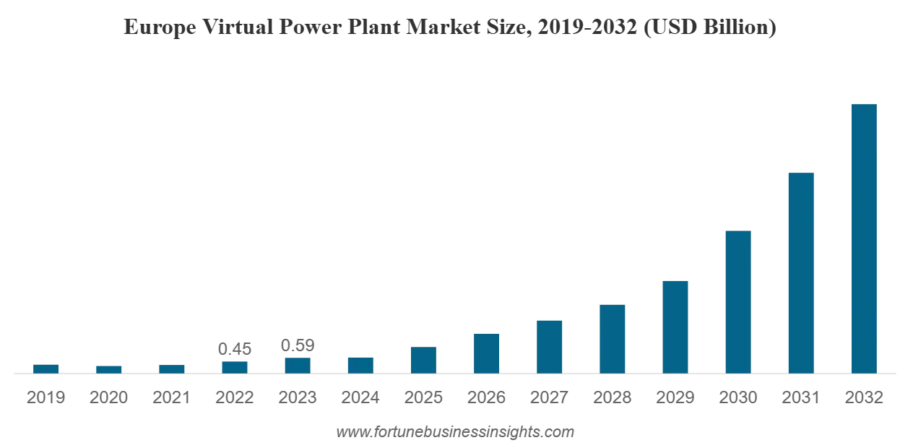
Credit: Fortune Business Insights
Rapid urbanization burdens power distribution networks, causing grid congestion, poor integration of DERs, and inadequate demand response. As a result, startups are developing virtual power plants that leverage software and control systems to aggregate and orchestrate a network of diverse energy resources. They include solar panels, battery storage, electric vehicles (EVs), and more.
By integrating energy resources into VPPs, operators gain enhanced flexibility in managing electricity supply and demand. They enable better grid optimization, load balancing, congestion management, and renewable integration.
Moreover, VPPs provide the framework for effective demand response programs and enable energy companies to mitigate the issue of intermittency in renewable grids.
Evergen optimizes Digital Energy Supply Chain
Evergen is an Australian startup that provides a platform to optimize the digital energy supply chain. The platform leverages virtual power plants to manage distributed energy resources (DERs) such as solar panels, batteries, and electric vehicles.
It also uses machine learning to enhance the efficiency and performance of these assets, allowing for real-time monitoring and control, extensive reporting, and customizable dashboards. The platform also ensures lower energy costs for consumers, increases grid stability, and supports renewable energy integration.
Lumena Energy specializes in Energy-as-a-Service
Lumena Energy is a US-based startup that aids energy demand response with virtual power plants. The startup’s VPP enables customers to participate in peer-to-peer energy trades during high-demand periods, earning rewards as a result. It also creates a decentralized network that leverages AI to efficiently respond to supply and demand. This system stabilizes the power grid and also reduces reliance on costly power plants.
Further, Lumena Energy’s Parsecc platform utilizes IoT to interconnect prosumers’ solar power systems with others in their grid. Furthermore, the platform allows users to monitor their system, engage in energy trading, and exercise voting rights among users, local government, and infrastructure providers.
9. Asset Management for Power Distribution
Utility operators spend considerable resources in managing assets to counter aging infrastructure, inefficient maintenance practices, and suboptimal resource allocation. These issues lead to increased downtime and operational costs. To tackle these issues, energy companies leverage predictive analytics, machine learning, and Internet of Things (IoT) sensors to monitor equipment health and performance in real-time.
Such solutions facilitate proactive maintenance and reduce unplanned outages. Additionally, asset management systems incorporate data-driven decision-making processes to optimize resource allocation and prioritize investments in critical infrastructure. These measures enhance the efficiency, reliability, and lifespan of power distribution assets, ensuring a more resilient and cost-effective electricity supply.
Airpelago delivers Drone Inspection Services
Airpelago is a Swedish startup that provides end-to-end inspection services of power lines for utility providers. The startup’s software Airpelago Power is a solution for large-scale inspection of power lines. It utilizes drones and ensures consistent data quality crucial for effective AI analysis. The startup automates the entire process, from flight planning to data management, also offering live progress tracking along with features for cooperation between pilots.
Airpelago Power provides power line inspection for storm damage and service line defects. It also performs infrared and LiDAR-based inspection for high-detail imaging and point cloud generation of powerline infrastructure. This safer and greener alternative is more efficient and cost-effective than traditional manual inspection methods in detecting powerline faults and defects.
enSights simplifies Renewable Energy Asset Monitoring
enSights is a US-based startup that provides energy optimization technology for renewable energy portfolio management. The startup’s platform combines AI and machine learning algorithms to optimize the efficiency and productivity of renewable energy assets. The solution also offers real-time operational, maintenance, and financial visibility into all connected assets.
Additionally, the platform features live performance monitoring, corrective and preventive maintenance, advanced reporting, and more. These features enable energy asset investors and owners to better manage their portfolios, returns on investment (ROI), and profits.
10. Digital Twin for Electric Grids
Many utility operators suffer from limited visibility into network operations, lack real-time situational awareness of their assets, and have difficulty managing infrastructure upgrades. Digital twins overcome these problems by delivering virtual replicas of the physical power distribution system. They combine real-time data from sensors, communication networks, and other sources to provide a comprehensive and dynamic representation of the power distribution network.
By leveraging advanced analytics and simulation capabilities, digital twins enable operators to monitor, analyze, and predict the behavior of the power system in real-time. Moreover, digital twin platforms facilitate scenario analysis and what-if simulations. This enables grid operators to assess the impact of infrastructure upgrades, renewable energy integration, and demand variations.
Plexigrid develops Software for Distribution System Operators
Plexigrid is a Swedish startup that provides grid-centric flexibility management systems. The startup’s solution leverages a real-time digital twin and comprises three technology layers – a smart meter, advanced analytics, and modeling. Its grid analytics tool Tatari aids distribution network planning and operation and offers real-time digital twin simulations of a grid’s past, current, and future states.
The startup also leverages advanced analytics to simulate three-phase unbalanced networks across voltage levels. Lastly, it aids in modeling, forecasting, and controlling of DERs. Further, Plexigrid’s products Ari and Tatari consolidate all grid data in one place, enabling network operators to improve monitoring and analytics performance.
Gradyent creates a Digital Twin for Heating Grids
Gradyent is a Dutch startup that offers a real-time digital twin Platform for the optimization and decarbonization of heating grids. It creates a digital copy of the entire heating grid by incorporating geographical, weather, and sensor data as well as physics-based models and AI. The platform then provides comprehensive insights into the network, even for areas lacking data or smart meters. This allows for enhanced grid optimization and future scenario simulations.
The platform also features real-time monitoring, automated data validation, thermohydraulic solvers, demand forecasting, and live setpoints for dynamic temperature control. Gradyent’s solution thus improves grid performance, reduces CO2 emissions, lowers operating costs, and supports the integration of renewable energy sources. By enabling district heating companies to achieve higher efficiency and sustainable operations, Gradyent accelerates the transition to a carbon-free heating system.
Discover all Electricity Distribution Trends, Technologies & Startups
Grid optimization software that utilizes machine learning, AI, and digital twins is enhancing the responsiveness and efficiency of current and future power grids. Further, smart grids dynamically balance renewable energy output by integrating multiple sources of renewable energy for grid stability. Innovations in ultra-high voltage transmission lines are further enabling long-distance, low-loss power transmission.
Meanwhile, blockchain technology in energy trading fosters increasing transparency and reducing energy transaction costs. The power distribution trends and startups outlined in this report only scratch the surface of trends that we identified during our data-driven innovation & startup scouting process. Identifying new opportunities & emerging technologies to implement into your business goes a long way in gaining a competitive advantage.
